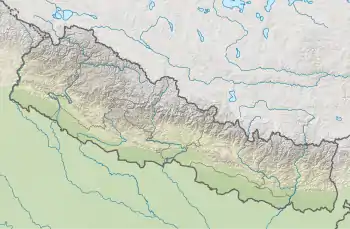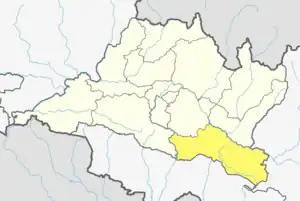Ghyanglekh Rural Municipality
Ghyanglekh is a Rural municipality located within the Sindhuli District of the Bagmati Province of Nepal. The municipality spans 166.77 square kilometres (64.39 sq mi) of area, with a total population of 13,661 according to a 2011 Nepal census.[1][2]
Ghyanglekh (RM)
घ्याङलेख गाउँपालिका | |
|---|---|
 Ghyanglekh (RM) Location  Ghyanglekh (RM) Ghyanglekh (RM) (Nepal) | |
| Coordinates: 27°21′0″N 85°48′45″E | |
| Country | |
| Province | Bagmati |
| District | Sindhuli District |
| Wards | 5 |
| Established | 10 March 2017 |
| Government | |
| • Type | Rural Council |
| • Chairperson | Mr. Jagat B. Bholan |
| • Vice-chairperson | Mrs. Durga Devi Sunuwar |
| • Term of office | (2017 - 2022) |
| Area | |
| • Total | 166.77 km2 (64.39 sq mi) |
| Population (2011) | |
| • Total | 13,661 |
| • Density | 82/km2 (210/sq mi) |
| Time zone | UTC+5:45 (Nepal Standard Time) |
| Headquarter | Bastipur |
| Website | ghyanglekhmun |
On March 10, 2017, the Government of Nepal restructured the local level bodies into 753 new local level structures.[3][4] The previous Amale, Bastipur, Tamajor, Netrakali and Shanteshwari VDCs were merged to form Ghyanglekh Rural Municipality. Ghyanglekh is divided into 5 wards, with Bastipur declared the administrative center of the rural municipality.
Demographics
At the time of the 2011 Nepal census, Ghyanglekh Rural Municipality had a population of 13,761. Of these, 73.9% spoke Tamang, 9.9% Nepali, 6.8% Magar, 4.2% Newar, 2.4% Thangmi, 2.3% Sunwar, 0.3% Urdu, 0.1% Maithili and 0.1% other languages as their first language.[5]
In terms of ethnicity/caste, 73.9% were Tamang, 7.1% Magar, 5.8% Newar, 3.3% Kami, 3.0% Chhetri, 2.4% Sunuwar, 2.4% Thami, 0.6% Hill Brahmin, 0.6% Damai/Dholi, 0.3% Musalman, 0.1% other Dalit, 0.1% Gharti/Bhujel, 0.1% Sarki and 0.2% others.[6]
In terms of religion, 77.5% were Buddhist, 20.3% Hindu, 1.1% Christian, 0.9% Prakriti and 0.3% Muslim.[7]
In terms of literacy, 49.1% could read and write, 5.5% could only read and 45.4% could neither read nor write.[8]
References
- "District Corrected Last for RAJAPATRA" (PDF). www.mofald.gov.np. Retrieved 17 July 2018.
- "स्थानीय तहहरुको विवरण" [Details of the local level bodies]. www.mofald.gov.np/en (in Nepali). Ministry of Federal Affairs and Local Development. Retrieved 17 July 2018.
- "New local level structure comes into effect from today". www.thehimalayantimes.com. The Himalayan Times. 10 March 2017. Retrieved 17 July 2018.
- "New local level units come into existence". www.kathmandupost.ekantipur.com. 11 March 2017. Retrieved 18 July 2018.
- NepalMap Language
- NepalMap Caste
- NepalMap Religion
- NepalMap Literacy
